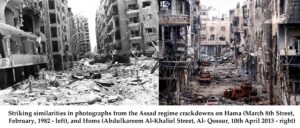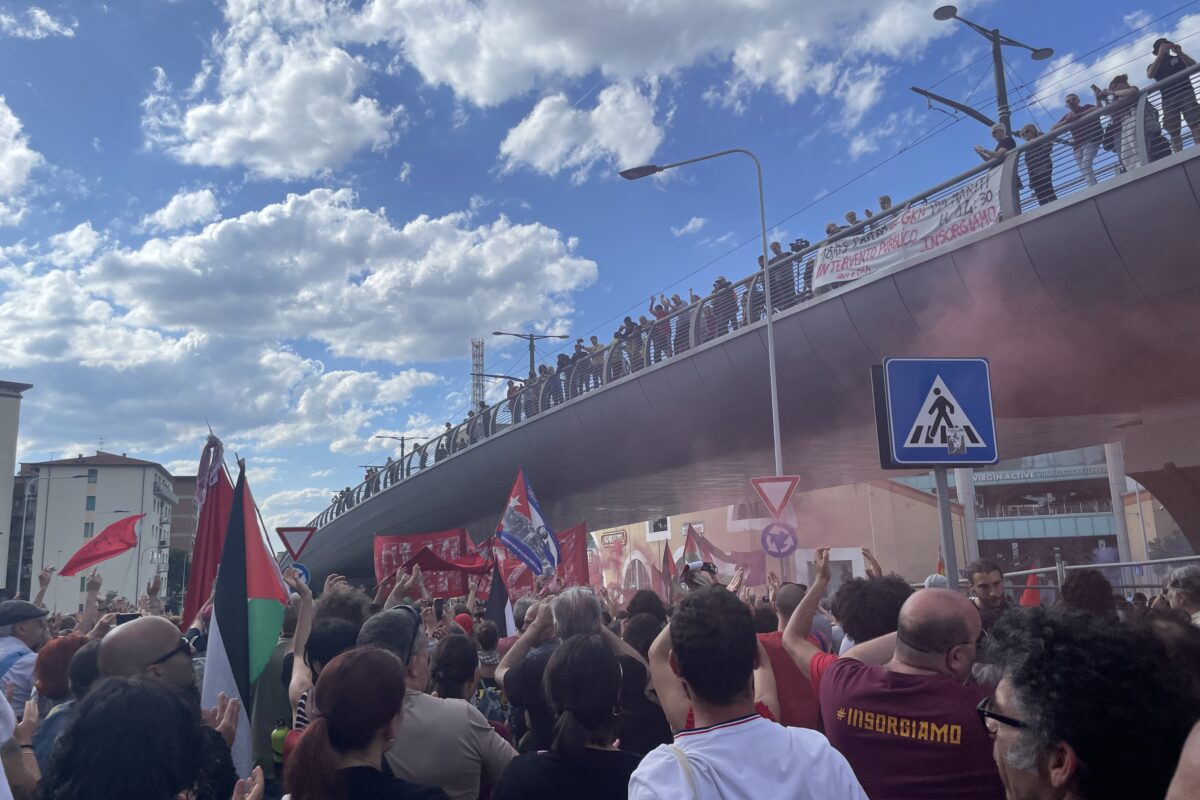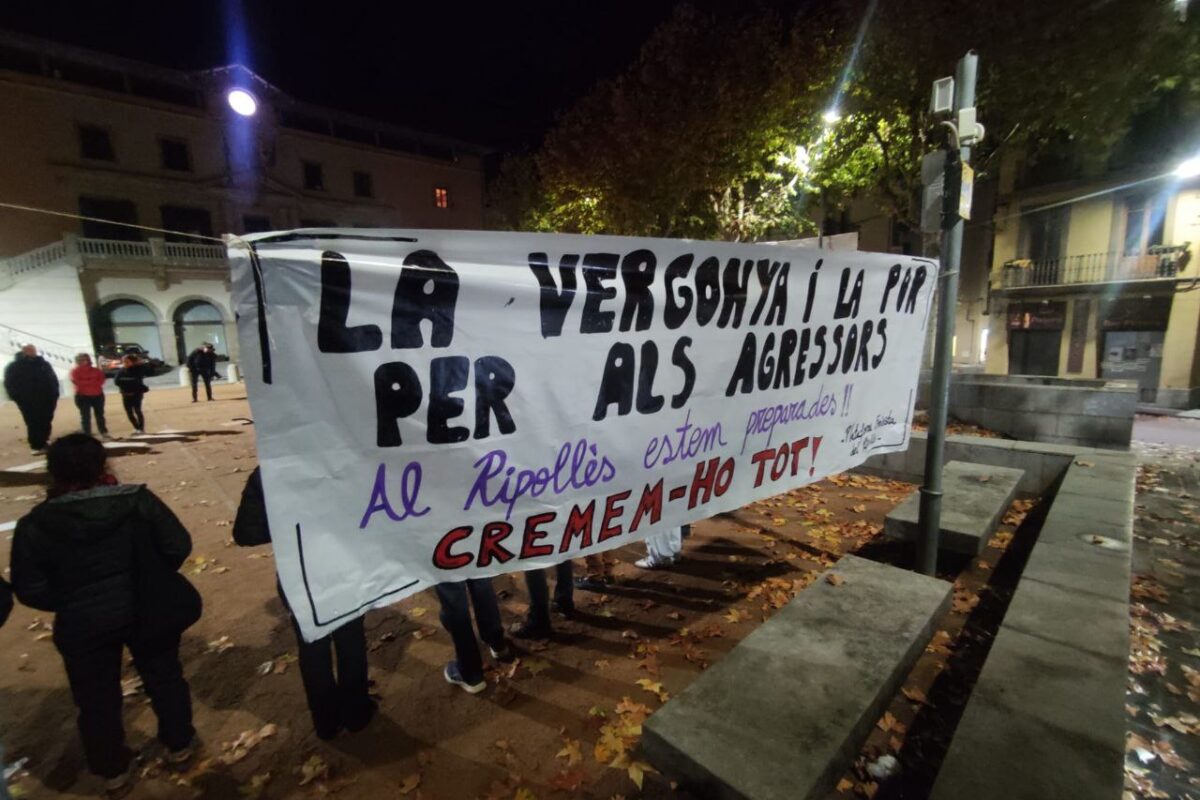Introduction
Former Syrian pilot Raghid al-Tatari, who was imprisoned for 43 years for refusing to bomb Hama in 1982, has regained his freedom. Now in his early seventies, al-Tatari was released from Tartus Central Prison after the regime’s collapse and Bashar al-Assad’s flight. Arrested” at 27, he is known as the “Dean of Syrian Prisoners.”

Raghid al-Tatari, posted by @tamerqdh
“Our execution was scheduled for today, just half an hour ago — me and this man, along with 54 others. We were all set to be executed,” recalled a Syrian man on the eve of Damascus’s liberation. Thousands were freed from Saydnaya Prison, known as the “Human Slaughterhouse,” where over 30,000 detainees have reportedly been killed, and tens of thousands tortured.
In another haunting video, terrified young girls hesitate to leave their cells, fearing Assad’s soldiers. One child, trembling, asks, “What if they are still there?” Her fear reflects the deep psychological toll of Assad’s regime, which had instilled a pervasive sense of oppression and fear. Her hesitation was not an isolated experience.
It is difficult not to be joyful after scenes of prisons being liberated. After all, if the Syrian Revolution’s only outcome was freeing the innocent, it would have been reason enough to be optimistic. However, almost 14 years after the outbreak of the Arab Spring, it has taught us to be more cautious and wait until the events crystalize.
The internet was taken by storm in the last couple of days. The rebels marched from their few remaining strongholds in the north of Syria, toppling the Russia and Iran-backed regime in twelve days. They were called heroes by some, extremists by others and pawns of the west by a few.
In such situations, and in this polarised social media world, people often gravitate toward simplistic black white positions, not out of an understanding of reality but to support a camp. This is an “Ultras mentality”, where supporting the “team” takes precedence over reviewing the facts in order to understand, build logical premises, and derive accurate conclusions.
“Tyrants pave the way for invaders.” This insightful quote comes from Ibn Khaldun, a 14th-century Arab philosopher from modern-day Tunisia and often nicknamed the father of sociology. It was echoed in Syrian media during the 2003 American invasion of Iraq as part of the Baath Party of Syria’s propaganda war against its ideological sibling, the Baath Party of Iraq.
The Baath Party split in 1966 after a coup brought Salah Jadid to power in Syria, and the division deepened when the Iraqi branch denounced its Syrian counterpart. In 1970, Hafez al-Assad seized power, establishing his so-called “republic of fear.” Despite their rivalry, the fates of the last leaders of both the Iraqi and Syrian Baath parties mirror each other. Saddam was hanged after years of bloody repression against his own people, while Bashar became a refugee, after forcing millions into exile. Both left their nations occupied and fragmented, sunk in sectarian violence and civil war, confirming the truth of Ibn Khaldun’s quote.
On the 28th of November 2024 in the first days of the opposition offensive when it had already freed Aleppo, analysts were still speculating about the intentions of the rebels. Prevailing opinion was that the rebels wanted to expand their territory to enhance their position at the negotiating table. It wasn’t until the liberation of Hama that the offensive had earned its current prestige and the potential fall of Assad slowly became a probability.
Hama is the 4th largest Syrian city, it is famous for its water wheels on the Asi river and one of the most horrible massacres of the 20th century. Hafiz Al-Assad, the perpetrator of Syria’s 20th coup within twenty years (1949-1970), was steadily and brutally consolidating power in the first decade of his rule. This was met by several uprising attempts, some peaceful, some violent, all squashed by the Assad regime. By 1981, opposition coup plots led by the Muslim Brotherhood were exposed, prompting Assad to order the devastating 1982 offensive of Hama.
On February 2nd, 1982, 12,000 Syrian forces marched on the city but faced resistance, leading to a withdrawal and the start of indiscriminate aerial and artillery bombardment. For 27 days entire neighborhoods were leveled to the ground, including homes, mosques, and clinics, causing extensive civilian casualties.
Survivors describe horrific scenes: a newborn torn apart by soldiers in front of his mother, civilians crushed under tanks, and over 10,000 men arrested in a single day, disappearing without a trace.
The massacre led to between 30,000 and 40,000 civilian deaths, and thousands remain missing. Entire neighborhoods were destroyed, along with 79 mosques and three churches. Widespread fear silenced survivors for decades, while the regime resettled loyalists to maintain control. Thomas Friedman, the first journalist to visit Hama after the massacre, described Assad’s actions as “Hama Rules,” meaning there are no rules and that Arab dictators will do anything to stay in power.
The song “Ya Haif” (Oh Shame!) has become an anthem at Syrian protests. Through his masterful lyrics and the soulful sounds of the oud, Samih Choukair tells the story of the Syrian revolution, stripping it from geopolitical complexities.
“يا حيف وأطفال بعمر الورد تعتقلن كيف”
“Oh What a shame! Children in the bloom of youth, and you arrest them — how could you?”
Choukair refers to Mouawiya Syasneh, who was just 14 years old when his actions helped ignite the revolution which spiraled into a vicious civil war.
In February 2011, Syasneh and three classmates in the southwestern city of Daraʿā near the Jordanian border decided to show solidarity with the wave of pro-democracy protests sweeping their neighbouring Arab countries, during what became known as the Arab Spring. Inspired by the toppling of long-standing dictators in Tunisia and Egypt, which they had followed on TV, the seventh-graders decided to send a bold message to Syria’s authoritarian leader.
With a can of spray paint, they drew graffiti on a sandy-colored wall at their school that read: “Your turn next, Doc” — a pointed reference to Syrian President Bashar al-Assad.
The act of defiance did not go unnoticed. On the orders of Assad’s cousin “Atif Naguib”, Syrian authorities arrested and tortured 15 children, including Syasneh’s friends. One boy, only 13 years old, succumbed to the brutal injuries.
“شافو البواريد يما. قالو اخوتنا هن ومش رح يضربونا”
“They saw the rifles, mama. They said, ‘They’re our brothers; they won’t shoot us.’”
Outrage over the detention and abuse of the children quickly sparked protests in Daraʿā, which marked the beginning of the Syrian revolution. What started as calls for freedom and reform spiraled into a devastating conflict that has killed more than 500,000 people and displaced over half of Syria’s population. To this day, the Syrian war remains one of the gravest humanitarian crises in modern history.
“ضربونا يما بالرصاص الحي”
“They shot us, mama, with live bullets.”
For nine to twelve months, Syrian citizens engaged in peaceful demonstrations. However, as these unarmed individuals took to the streets, Assad’s security forces responded with gunfire. While many soldiers followed orders and picked up their weapons, others refused to comply. Among those who refused, some chose to defect.
“متنا. بايد إخوتنا باسم امن الوطن واحنا مين إحنا “
“We were murdered. At the hand of our brothers for the sake of the Homeland’s security, aren’t we a part of that Homeland?”
It was the “Hama rules” again. Like father like son, Bashar didn’t hesitate to massacre his own people once felt his kingdom was fading.

After the revolution became militarised and received Turkish, Arab and Western support, the Syrian Free Army was created. The rebels demanded transition to democracy and the fall of the regime. What was Assad’s response? The regime’s supporters often chant “Assad or burn the country,” and indeed he did.
“واحنا اللي قلنا اللي بيقتل شعبو. خاين. يكون من كاين”
“And it was us who said,
‘Whoever kills their own people is a traitor, no matter who.’”
As the regime lost more territory, it intensified its indiscriminate bombardment of opposition-controlled areas. Sohail Al-Hassan, a notorious Assad commander, introduced the use of “explosive barrels”, a crude and devastating tactic that razed entire neighborhoods through “dumb” bombing. However, the regime did not stop there. Operating under the grim principle that “there are no rules,” it escalated its attacks by deploying chemical weapons against opposition-held territories.
“تاري السجان يما كلمة حرية وحدا هزتلو اركانو”
“Oh mama, Our jailer, a single word — freedom — shook his very foundations.”
In 2014, facing isolation internationally and from the Arab League as well as global support for the rebels, the Syrian regime decided to demonize the revolution to justify its suppression under the guise of fighting “extremism”. Bashar al-Assad released thousands of “jihadists” from prison, knowing they would take up arms. His goal was to discredit the revolution and frame his crackdown as counter-terrorism. Assad exploited these contradictions, allowing the world to focus on ISIS while relying on Iran and Russia to crush the revolution’s remnants. Or so he thought.
The Assads are gone, should there be regrets?
Hundreds of thousands of deaths, countless chemical attacks on civilians, and over 10 million displaced both within Syria and abroad — and yet, some still mourn the Assads. Their argument often hinges on the notion that Assad’s fall would remove one of the last barriers to U.S. and Western hegemony. However, this claim can be misleading given the course of current events. Were the Assads truly anti-imperialist? Were they champions of pan-Arabism? Were they staunchly anti-colonial? The answer is unequivocally no.
For Hafez al-Assad, a Ba’athist Arab nationalist who opposed peace treaties with Israel and mobilized public opinion against them, one might expect him to prioritize Arab unity over his personal feud with Saddam Hussein. Yet, this never happened. Instead, Assad sold out Saddam to the Americans in exchange for Lebanon. He sent Syrian soldiers to fight under the American-led international coalition in exchange for securing Lebanon as his sphere of influence.
According to Abdo Fayed, Hafez Assad, an imperialist in his own right, had long pursued a strategic foothold to compensate for the loss of the Golan Heights, with Lebanon — particularly Beirut — presenting the ideal opportunity to advance his vision of a “Greater Syria.” Since 1976, Assad had maintained a presence in the Bekaa Valley through Israeli-American agreements. Following the 1989 Taif Agreement, Assad secured a lasting military presence in Lebanon, solidifying Syrian dominance there. In return, the Americans received Arab legitimacy for their war against Saddam.
Another common pro-Assad argument relies on the recurring narrative of blackmail: “If Assad weren’t in power, extremism would take over Syria.” Bashar al-Assad quickly grasped the implications of the post-Iraq invasion world: his regime could be next. Drawing from the Egyptian regime’s playbook during the Soviet invasion of Afghanistan, Assad facilitated the movement of fighters to conflict zones like Iraq and Afghanistan, where they would battle US forces. Upon their return, he rounded them up and weaponized their presence as a threat. This “scarecrow tactic” was used to deflect calls for reform and shield his regime from existential threats, such as the backlash following Bashar’s complicity in the 2005 assassination of Rafik al-Hariri, which led to the Syrian army’s humiliating withdrawal from Lebanon under international pressure.
What’s next?
Whoever the next rulers of Syria may be, governing the country will not be an easy task. Syria remains home to tens of armed groups divided along ethnic, religious, and ideological lines, with every faction operating in crisis mode. For now, there appears to be a general consensus among most groups that these differences should be resolved through dialogue rather than force, while maintaining what remains of the Syrian state and safeguarding minority rights.
As promising as this approach sounds, it could quickly unravel given the geopolitical challenges surrounding Syria. The regime’s collapse was unexpectedly rapid, reshuffling the strategies of all geopolitical players, including Turkey who supported the offensive, which did not anticipate such swift success. Meanwhile, counter-revolutionary forces and their backers are likely to exploit these contradictions as the situation continues to evolve.
The Syrian rebels, despite their gains, find themselves in an unenviable position. To the North, the Turks are poised to pounce on the Kurds, emboldened by the incoming Donald Trump administration, which has signaled multiple times its intent to withdraw from the region and leave it to its own fate. Nonetheless, a stable and secure Syria aligns with Turkey’s interests, especially given that the Syrian refugee crisis remains the top issue for Turkish politicians at the ballot box. In this regard, Turkish interests intersect with those of certain Arab states.
Arab dictators, particularly the wealthy Gulf nations, are wary of the precedent set by an armed populace successfully overthrowing an Arab regime. However, it is also in their interest to support some semblance of stability in Syria to deter another wave of refugees and to curtail Iranian influence in the region. That said, they may hope to install a more ideologically aligned leadership at a later stage.
For Iran, once the primary backer of the Syrian state, the stakes are existential. Syria is the linchpin of its regional hegemony, and losing it could unravel its broader ambitions. Iran still possesses the capacity to stir unrest within Syria and along its borders for ideological or strategic reasons.
To the South, Netanyahu and company see this as a historic opportunity to advance the vision of a “Greater Israel”, positioning themselves to take further steps in the region amidst the unfolding chaos.
Internationally, the United States has long been invested in empowering Kurdish fighters who are US and Israel friendly and capable of countering Iranian expansion. This strategy is supported by historical evidence, such as Kurdish collaboration with Mossad during their uprising in Iraq. The question remains: will the Pentagon, the State Department, and perhaps Netanyahu succeed in convincing Trump to continue this approach?
The Russians have invested billions in Syria over the past decades, securing a 49-year lease of the Hmeymim Air Base on the Mediterranean, which provides them with a foothold in the gas-rich region and allows them to observe any NATO movements in the region. Their presence in Syria also marks a significant shift, separating the image of a bogged-down Russia after the fall of the USSR, which allowed its allies Saddam and Qaddafi to fall, from the current vision of Russia as an international power fighting for global dominance. This transformation lends Russia the prestige of an empire, something deeply important to Putin. It is difficult to imagine him relinquishing such gains to other regional or international players.
There have been some regional and international signals indicating a willingness among certain players to cooperate with the next regime in Syria. Most notably, Russia has allowed the Syrian revolution flag to be flown at the Syrian embassy in Moscow and has issued statements suggesting open communication channels with the Syrian rebels.
Iran, known for its pragmatism, has also begun courting the Syrian rebels. Their ally, Yemen’s Houthis, have hinted their intent not to be an enemy of the rebels if they join the fight against Israel. Additionally, Iranian media has shifted its terminology, referring to the Syrian rebels as “Syrian armed groups” instead of “terrorists”, a label they had used consistently over the past decade.
Netanyahu was the first to act, launching a ground incursion into Syria and conducting hundreds of airstrikes within hours. These strikes targeted what Israel described as the Syrian Army’s air force, air defence and maritime capabilities, ensuring Israeli air and maritime dominance. This move grants Israel the freedom to annex additional territory without facing aerial resistance, bomb Hezbollah transit routes at will, and ensure that any future rulers of Syria lack the air capabilities needed to dominate the country. Ultimately, this strategy aims to prolong Syria’s state of instability and gives Netanyahu an easy victory to sell at home.
While the future remains uncertain, two facts are undeniable. First, Syria will continue to be a battleground for regional and international powers, as it has been for the past decade, with the specter of partition still looming on the horizon. Second, the Syrian people, like all Arab peoples, have no true friends among states. They must remain cautious of both East and West, as well as of Arabs even more than non-Arabs. No one is genuinely committed to bringing democracy or freedom to the Arab world.
Between Golani and Ahmed Al Sharah: Was Pest replaced by Cholera?
It is important to stress that the burden of the Assads is tremendous. Five decades of torment and repeated genocides will still haunt Syria for centuries to come. Any party — literally any — that would lift this nightmare from the chests of the Syrians would earn tremendous credit among the grieving population. Scenes of Syrians tearing down statues of al-Assad, lining up at the Turkish-Syrian border to return, or shedding tears of joy upon learning that a loved one, who had been forcibly disappeared for 12 years, was found alive in Assad’s dungeons, are clear evidence of this.
However, there are many who, despite their joy, remain pessimistic about the future. Although the situation is still unfolding, as no single party has been able to dominate Syrian territory yet, given the fact that “Islamists” are the ones holding arms, there seems to be a general direction for the next governing elite within the Syrian revolution.
Amidst the Western propaganda frenzy that stigmatizes every Muslim as a terrorist, along with the US, EU, and Russia’s political manipulation of international law and terror-lists, the term “terrorist” has been rendered effectively meaningless. This distortion is further underscored by their appalling history of committing and supporting genocides and atrocities.
In the Western sphere, comparisons between Hayat Tahrir al-Sham (HTS) who have led the offensive and the Taliban quickly gained prominence, with a focus on potential suppression of human rights, particularly women’s rights. However, this reductive perspective ignores not only many critical facts but also overlooks the root causes of extremism. These roots are deeply tied to the Western colonial legacy, the ongoing decades long crusade of bombardment and occupation, and support for brutal dictators, including Assad himself.
This narrative also underscores the West’s hypocrisy towards this region. Why does the human rights situation take center stage when it involves adversaries like Iran or the Taliban, yet becomes a lesser priority when the violators are Western allies such as Sisi, Saudi Arabia, or Netanyahu? Furthermore, why does Western media overlook examples where “Islamists” have come to power without imposing restrictions on women’s freedoms and, in some cases, have even fostered prosperity? Cases like Malaysia, Turkey, and the short-lived experiments in Tunisia and Egypt serve as evidence of this double standard.
This is not a call to bury our heads in the sand when it comes to extremism and war crimes committed by revolutionaries or adversaries of the west. Despite Western hypocrisy, the connection between HTS and groups like ISIS and Al-Qaeda is indeed a worrying and complicating factor. It could also potentially bring more enemies than allies to the Syrian revolution. Despite their rebranding and shift in narrative following an alleged ideological review — whether genuine or merely for show — it is a clear sign for the Syrian people. From all backgrounds, civilians and fighters alike, Syrians must ensure that no single faction monopolizes the revolution and political sphere, abandoning any sort of exclusionary rhetoric.
Another aspect to explore in this topic is the subtle mutual praise exchanged between the HTS leader and the US President. In an interview with the CNN, the HTS leader hinted that he might accept a U.S. troop presence in Syria, provided it is framed within a ‘legal’ context. President Biden, on the other hand, acknowledged that some rebel groups are “saying the right things now.” This exchange of approval could, if Syrians are not vigilant, pave the way for the US to support a new Syrian dictatorship. Such a regime might not be entirely friendly but could remain non-hostile toward Israel, while ensuring Syria avoids aligning with Iran under the pressure of US sanctions.
“سمعت هالشباب يما الحرية عالباب يما. طلعو يهتفولا”
“The youth sensed it, mama: Freedom is at the door, mama. They went out calling for it.”
The key determinant for the future, despite the rebel affiliations, is the diversity of the Syrian people and revolution. They include not only “Islamists” but also secularists, conservatives, leftists, and liberals; they span across ideologies, religions, and ethnicities. Some of these factions are armed. Rebuilding a dictatorship or reinventing a theocracy after all this bloodshed in the struggle for freedom and democracy would be no easy task. While it’s not impossible — other Arab Spring countries have regressed after briefly tasting freedom — the hope lies in the Syrian people, civilians before militants. They possess the collective knowledge of their revolution and neighboring experiences, making it unlikely that they will allow any faction to impose an exclusionary ideology. Their focus must be on rebuilding a true Syrian state, founded on the sovereignty of the constitution, law, stable institutions, and the protection of political, economic, intellectual, and media freedoms for all, especially the minorities.
They must resist the old narrative used to suppress people in the name of “No voice is louder than the voice of battle.” Establishing freedom in the region is an extremely difficult task, with countless enemies, and it requires patience and unity. The priority from day 1 should be the interests of the poor, ordinary citizens, and the economic reform of the country.
“والشعب مثل القدر. والامل باين.”
“The people are like destiny, and hope is evident.”
Freedom and democracy in Syria are distant, almost impossible dreams, and they face many enemies. The Syrian revolution stands at a crossroads, with all paths still open. What remains constant is the wisdom behind Ibn Khaldun’s quote at the beginning of the article, a lesson unheeded by Assad and Saddam, which led their nations to their current state. This should serve as a vital lesson for the revolutionaries, it is the only way to avoid the same destiny. We must also remember while engaging with the Syrians that the Syrian revolution belongs to its people — not to any militant group or political ideology.






